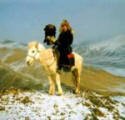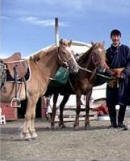
- Adayev Kirghiz - |
|||
|
The Adayev Kirghiz still remains in large numbers, and is the purest and most typical representative of the Mongolian horses. They are bred in the vast area from the Caspian Sea to the Central Asia region, from Kyrgyzstan, Kazakhstan, Tajikistan, and China, which has an area of about three million square kilometers. This area consists of almost half of the Soviet Union. The Adayev Kirghiz ponies are late in maturing because they require five years for full development. They are easy keepers, satisfied with little food, even if it's of poor quality. Despite this, they remain very healthy and with mediocre food and care have a long life. They are known for their speed and endurance and without any extra effort on their part can gallop for over four hours. These characteristics of the Adayev Kirghiz horses are most likely a result of their adaptation to the nomadic life of the Kirghiz people. Although these people are mostly settled in this age, there still are a number of nomads still roaming. Very valued in this pony breed is their endurance over long distances, their speed and quickness, their un-spookiness, and their ability to endure hunger, thirst, bad weather, and other elements. They can stand up under rider or weight as a pack horse and are very reliable. We can only understand this toughness if we become familiar with the hard pasture lifestyle that the Kirghiz endured for many centuries, having adapted as well as the people. This breed spends most of its life outside under the sky, surviving blizzards, cold, freezing wind and rain, thunderstorms, heat, dust, and shortage of food. During food shortages they can often live like camels do off of stored fat in their bodies. In the winter they must forage for dry grass under the snow. These ponies can exhibit great endurance in the high mountains of low atmospheric pressure and thin air. They easily navigate the steep mountain climbs or descents into deep ravines. They are surefooted on narrow trails and through the crossing of deep strong streams. They can also walk with ease over large scattered rocks. Kirghiz mares are very good at milk production, and the indigenous people's favorite nutrition is the mare's milk, or Kumiss. It was and still is used for medical purposes quite often. The Don, Budyonny, and English Thoroughbred were used for the refinement of the Kirghiz breed. The improvement and large size of the Kirghiz horses is partly responsible on their recent breeding and raising and the additional feeding of hay during the winter months. Sometimes the poor development of the babies is dependent of the milking of the mares, so that the foals do not receive sufficient nutrition until after they've been weaned. The Adayev Kirghiz is a small horse, standing around 12.3 to 13.1 hands high. Their mares have a straight profile in the head, and the stallions tend to be slightly Roman Nosed. The Adayev Kirghiz horses carry their heads close to the ground because they have low set necks. This can be explained by their constant search for food. Their torsos are fairly long, tight, and often "sway-backed". Their loins are strongly tied in at the hindquarters, which is not unusual in most horse and pony breeds. The back along is somewhat short in this breed, although they have very wide, long hips. Their chests are not very wide, their legs are short with strong joints, tendons, and hooves. Their hind legs tend to be "cow-hocked", and fortunately, spavin, navicular, and hoof diseases are rarely present. Their summer coats are short and tight while during the winter the hair grows curly, very thick, and long. The Kirghiz ponies are usually palominos, chestnuts, bays, and occasionally paints or tigers.
Horse and Pony Breeds of the World
Kincade Lined Event Bridle
Wild Horses Coaster Set Hunter/Navy Lead Rope Small Horsehair Brush Weatherbeeta Turnout Sheet |
|||
|








